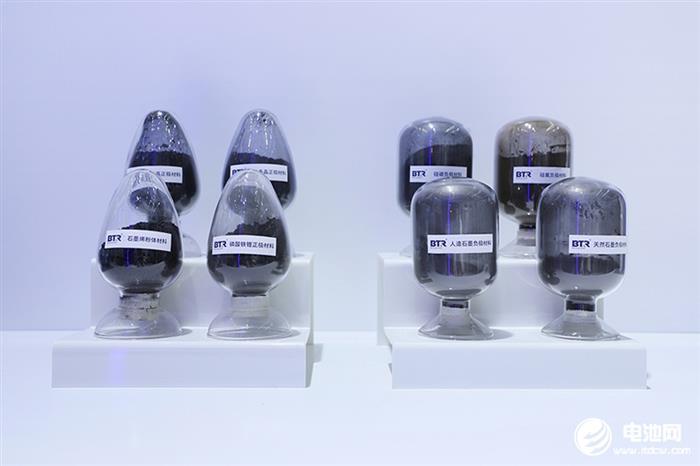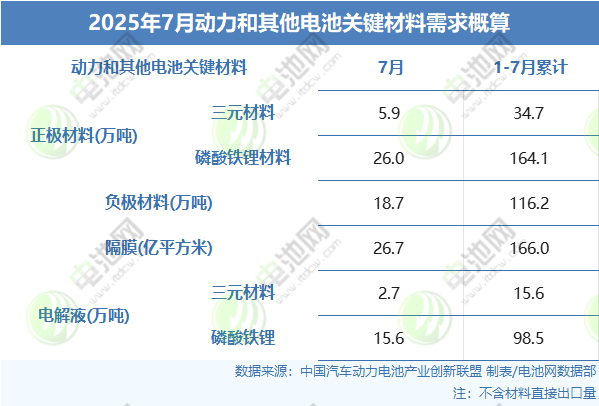LFP Dominates, Anode Monopoly! In the First Half of the Year, China’s Four Major Battery Materials Sweep the Globe
In the first half of 2025, Chinese companies demonstrated overwhelming dominance in all four major global material sectors: In the global loading volume of cathode materials, Chinese companies further solidified the "China-centric" pattern due to their global leadership in the lithium iron phosphate market; in the global loading volume of anode materials, Chinese companies accounted for as much as 95%; the share of separators was nearly 90%; and the share of electrolytes reached 87.3%.

The current battery new energy industry chain in China is complete, from upstream mineral resource development, core material preparation, to battery research and manufacturing, and then to terminal applications such as new energy vehicles, energy storage, and recycling, forming a closed-loop ecosystem. This full-chain advantage not only supports the rapid development of the industry in China but also holds a central position in the global market.
The supply and market landscape of the four key materials for global batteries—cathode materials, anode materials, electrolytes, and separators—are deeply involved with and dominated by the Chinese market.

According to the China Automotive Power Battery Industry Innovation Alliance.Demand estimation for power and other key battery materialsFrom January to July, China produced 347,000 tons of ternary materials for power and other batteries, 1,641,000 tons of lithium iron phosphate materials, 1,162,000 tons of anode materials, and 16.6 billion square meters of separators. The electrolyte for ternary batteries amounted to 156,000 tons, and for lithium iron phosphate batteries, it was 985,000 tons.
Recently, data released by the South Korean research institute SNE Research indicate that in the first half of 2025, Chinese companies have shown overwhelming advantages in the global four major material fields.
In the global loading of cathode materials, Chinese companies have further solidified the "China-centric" pattern by leveraging their global dominance in the lithium iron phosphate market. In the global loading of anode materials, Chinese companies account for as much as 95%; for separators, nearly 90%; and for electrolytes, 87.3%.Even in markets outside of China, the penetration of Chinese materials continues to increase, becoming a "stabilizer" in the global battery industry supply chain. Meanwhile, it further highlights the high dependence of the global market on the Chinese materials system.

The global loading volume of cathode materials for power batteries reached 1.1056 million tons, a year-on-year increase of 42.6%.
In the first half of the year, the total loading volume of cathode materials used in electric vehicles worldwide (including battery electric vehicles, plug-in hybrid electric vehicles, and hybrid electric vehicles; hereinafter the same) was approximately 1.1056 million tons, representing a year-on-year increase of 42.6%. Notably, in markets outside China, the loading volume of cathode materials reached 399,000 tons, up 26.0% year-on-year.
The loading volume of ternary materials was 465,800 tons, a year-on-year increase of 15.1%, continuing the trend of steady growth. The total loading volume of the lithium iron phosphate market reached 639,800 tons, a year-on-year surge of 72.6%, with a growth momentum significantly ahead of ternary cathode materials. Lithium iron phosphate accounted for about 58% of the total loading volume of cathode materials, making up more than half.
In terms of market share in the ternary materials sector, Ronbay Technology and LG Chem firmly hold the first and second positions, respectively. Yibin Libode, leveraging the growth in demand for high-nickel cathode materials, ranks third with a loading volume of 36,700 tons. Korean companies L&F (32,200 tons), Ecopro (29,700 tons), and POSCO (21,500 tons) also rank among the top; however, overall, Chinese companies show a more pronounced growth momentum. Leading companies like Reshine New Material and Easpring are fiercely competing for market rankings.
In the field of lithium iron phosphate materials, Hunan Yuneng ranks first with 169,900 tons, and Defang Nano ranks second with 89,800 tons. Wanrun New Energy follows with 81,100 tons, and Longpan Technology with 74,500 tons, ranking third and fourth respectively, both achieving double growth year-on-year. In addition, companies like Gotion High-Tech and Rongtong High-Tech have also expanded their market shares with loadings of 42,200 tons and 37,400 tons respectively. It is worth noting that the leading suppliers are all Chinese companies, fully demonstrating that the lithium iron phosphate cathode material market has formed a China-dominated pattern.
The global loading volume of negative electrode materials for power batteries reached 593,800 tons, a year-on-year increase of 40.8%.
In the first half of the year, the total loading volume of anode materials used in the global electric vehicle market was approximately 593,800 tons, representing a year-on-year increase of 40.8%. Among them, the loading volume in markets outside of China was 223,700 tons, a year-on-year increase of 25.1%.
In terms of market share, Shanshan Co., Ltd. (137,400 tons) and BTR (110,500 tons) rank first and second respectively, leading the global anode materials market. These two companies supply mainstream battery manufacturers such as CATL, BYD, and LG Energy Solution, while possessing a stable customer base and large-scale production capacity, forming core advantages. In addition, companies like Shantai Technology (62,200 tons), Kaijin Energy (56,400 tons), Zhongke Xingcheng (41,100 tons), and Zichen Technology (40,400 tons) have also entered the forefront, with year-on-year growth rates of 40%-70%, showing impressive performance.
In terms of market share by country of origin, Chinese companies hold approximately 95% of the global market, maintaining an absolute advantage. Chinese companies are further consolidating their market dominance by expanding production capacity and enhancing technological levels. As the electric vehicle market expands, the adoption rate of silicon-based composite anode materials continues to increase, and Chinese companies are deepening their collaboration with major battery manufacturers. Secondly, Korean companies account for about 2.8% of the market share, while Japanese companies account for 2.3%.
The global loading volume of electrolyte for power batteries reached 616,000 tons, a year-on-year increase of 45.2%.
In the first half of the year, the total amount of electrolyte used in registered electric vehicles worldwide was approximately 616,000 tons, representing a year-on-year increase of 45.2%. During the same period, the electrolyte loading in markets outside of China reached 203,000 tons, marking a year-on-year growth of 28.2%.
In terms of market share in the enterprise sector, in the first half of the year, Tianci Materials maintained its position as the market leader with a loading volume of 133,000 tons, representing a year-on-year increase of 29.3%. BYD followed closely with a loading volume of 105,000 tons, up 28.8% year-on-year. Capchem achieved a growth rate of 107.9%, with a loading volume reaching 92,000 tons. Guotai Huarong saw a slight increase to 42,000 tons. Zhuhai SVI performed impressively with a growth rate of 103.3% and a loading volume of 33,000 tons. South Korean companies Enchem (24,000 tons, +0.8%) and SBH (18,000 tons, +22.2%) also continued their steady growth momentum.
As for the market share by national origin of enterprises, Chinese companies still dominate the electrolyte market. As of the second quarter of 2025, Chinese companies hold a market share of 87.3%, while South Korean and Japanese companies account for 7.9% and 4.8% respectively. This data represents a slight decrease compared to the same period last year. Against the backdrop of a continuing consolidation of a monopoly dominated by Chinese enterprises, enhancing competitiveness becomes an increasingly important issue for non-Chinese companies.
The global installed capacity of power battery separators reached 7.69 billion square meters, an increase of 48.5% year-on-year.
In the first half of the year, the total loaded area of separators in electric vehicles registered globally was approximately 7.69 billion square meters, representing a year-on-year increase of 48.5%. During the same period, the separator loading volume in markets outside China reached 2.272 billion square meters, a year-on-year increase of 27.1%.
From the perspective of market share, Enjie Co., Ltd. maintained its market advantage with a loading volume of 1.993 billion square meters, a year-on-year increase of 22.7%. Leading Chinese companies, such as Senior Material (+65.3%), Zhongcai Technology (+39.4%), and Jinli Co., Ltd. (+59.9%), also continued their strong growth momentum. Additionally, companies like Zhongxing New Materials and Cangzhou Mingzhu expanded their market share with double-digit growth rates. South Korea's SK IE Technology achieved a year-on-year growth of 51.1%, reaching 210 million square meters.
From the perspective of market share by company nationality, Chinese companies occupy nearly 90% of the global market share, continuously dominating the market. Since the third quarter of 2023, the market shares of Japanese and Korean companies have shown a continuous downward trend. By the second quarter of 2025, Japanese companies will account for 7.3%, and Korean companies will account for 4.4%. With the strengthening of Chinese companies' market dominance, the competitive landscape in the global separator market between "non-Chinese companies" and Chinese companies is becoming increasingly polarized.
【Copyright and Disclaimer】The above information is collected and organized by PlastMatch. The copyright belongs to the original author. This article is reprinted for the purpose of providing more information, and it does not imply that PlastMatch endorses the views expressed in the article or guarantees its accuracy. If there are any errors in the source attribution or if your legitimate rights have been infringed, please contact us, and we will promptly correct or remove the content. If other media, websites, or individuals use the aforementioned content, they must clearly indicate the original source and origin of the work and assume legal responsibility on their own.
Most Popular
-

EVA Morning Prices on September 12: Most of the Market Holds Steady, Highest Rise of 50 Yuan
-

[PET Weekly Outlook] Polyester Bottle Chips Expected to Oscillate and Warm Up with Costs Today
-

Top Ten Personnel Changes in the Auto Industry: Insights into Industry Anxiety and Progress | Vision 2025
-

Domo Chemicals Files for Bankruptcy Protection in Germany! B. Braun Launches New Supply Assurance Program
-

List Released! Mexico Announces 50% Tariff On 1,371 China Product Categories






